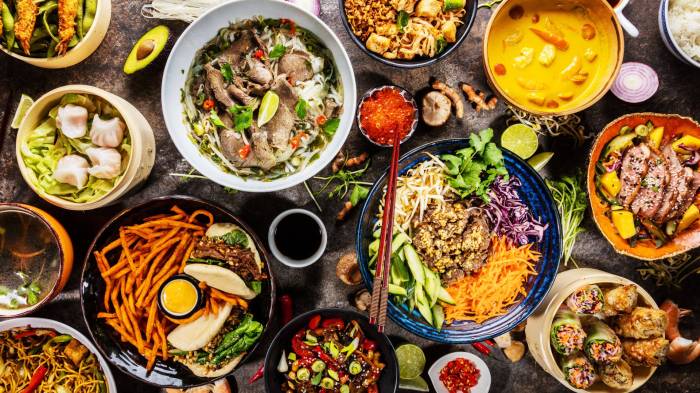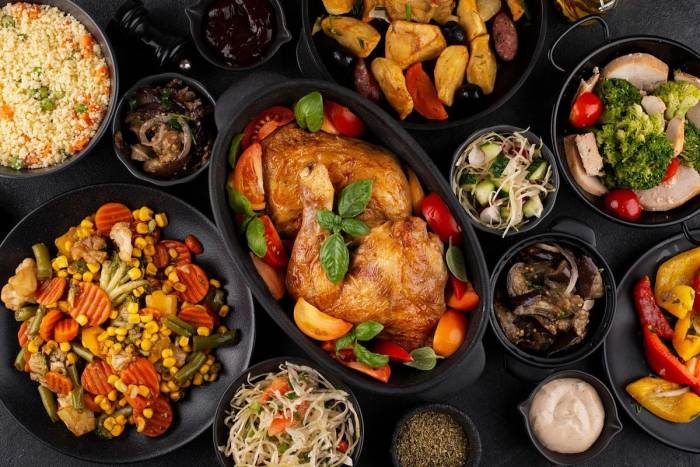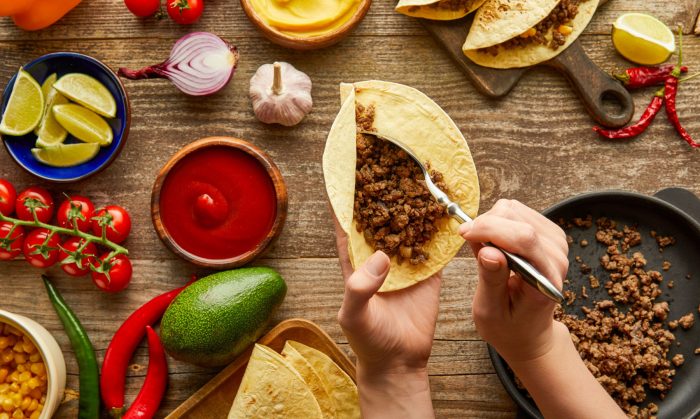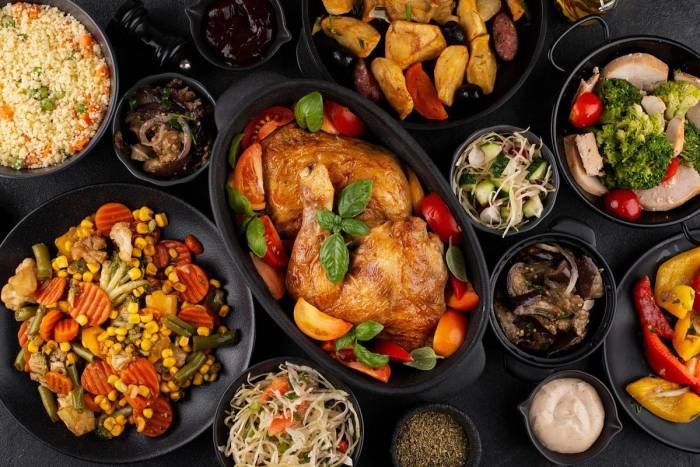What to eat and drink in Chile? This guide dives deep into the vibrant culinary landscape of Chile, exploring everything from traditional dishes to modern interpretations, and from regional specialties to national favorites. From the aromatic flavors of the north to the fresh seafood of the south, we’ll uncover the hidden gems and culinary treasures that await you on your Chilean adventure.
This comprehensive exploration covers the history, regional variations, and essential ingredients of Chilean cuisine. We’ll also highlight the significant role of wine in Chilean culture, showcasing the best drinks and food experiences throughout the country. Whether you’re a seasoned traveler or a curious foodie, this guide will help you navigate the diverse culinary world of Chile.
Introduction to Chilean Cuisine

Chilean cuisine boasts a rich tapestry woven from indigenous traditions and diverse influences. From the rugged Andes mountains to the sun-drenched coastal plains, the nation’s geography plays a crucial role in shaping its culinary landscape. This variety extends to its regional specialties, each reflecting unique ingredients and cooking methods. The evolution of Chilean cuisine is a fascinating journey through time, mirroring the nation’s history and cultural exchanges.The Spanish conquest significantly impacted Chilean food, introducing new ingredients and cooking techniques.
Over time, these elements merged with indigenous ingredients and preparation methods, resulting in a distinct culinary identity. The availability of fresh seafood, particularly along the coast, is a cornerstone of Chilean cuisine, alongside the abundance of fruits and vegetables.
Historical Influences on Chilean Food
The indigenous Mapuche people had a profound influence on Chilean cuisine. They cultivated potatoes, quinoa, and various other tubers, which became integral parts of the diet. Their traditional cooking methods, such as roasting and stewing, are still practiced today, although modified with European techniques.The Spanish conquest brought a wave of new ingredients, including wheat, livestock, and European spices.
These elements were integrated into existing culinary practices, creating a fusion of flavors and traditions. Furthermore, the introduction of livestock and grazing lands allowed for the development of traditional meat-based dishes, adding another dimension to the diverse Chilean culinary landscape.
Major Regional Variations in Chilean Cuisine
Chile’s diverse geography creates distinct regional variations in its cuisine. The varying climates, altitudes, and access to ingredients produce a unique flavor profile in each region. From the northern deserts to the southern Patagonian steppes, the cuisine reflects the natural bounty of each region.
Regional Specialties Comparison
| Region | Key Ingredients | Notable Dishes |
|---|---|---|
| Northern Chile (Atacama Desert) | Dried fruits, seafood, meats, grains | Empanadas (various fillings), grilled meats, seafood dishes (like fresh fish), various soups and stews using local ingredients. |
| Central Chile (Santiago) | Fresh vegetables, fruits, seafood, meats | Pastel de choclo (corn pie), lomitos (seafood dishes), curanto (traditional communal feast), asados (barbecues), and Chilean empanadas. |
| Southern Chile (Patagonia) | Seafood, lamb, potatoes, root vegetables, grains | Seafood stew (like cazuela), patas de chancho (pig’s feet), grilled lamb, fresh vegetables and potatoes, traditional Mapuche dishes (if applicable). |
The table above highlights some key ingredients and notable dishes from different regions. It’s important to remember that these are just examples, and the specific dishes and ingredients can vary depending on the particular location and chef. Furthermore, many dishes have variations within each region, reflecting the local traditions and available resources. For instance, while seafood is common throughout the coast, the specific types of fish and preparation methods may differ.
Popular Dishes and Ingredients
Chilean cuisine boasts a vibrant tapestry of flavors, deeply rooted in the country’s diverse geography and rich culinary traditions. From the coastal regions’ fresh seafood to the Andes mountains’ hearty stews, Chilean food offers a delightful exploration of South American culinary artistry. The influence of indigenous ingredients and Spanish colonial cooking methods creates a unique and delicious experience.The foundation of Chilean cuisine lies in its readily available and highly valued ingredients.
Chilean cuisine is a vibrant adventure! From the fresh seafood to the hearty stews, there’s a culinary treasure waiting to be discovered. If you’re planning a trip to Chile, definitely check out the amazing food scene. To sweeten the deal, you could be winning a luxurious cruise with the Marriott Bonvoy Celebrity Cruise contest, a chance to sample the incredible cuisine from a different perspective.
Marriott Bonvoy Celebrity Cruise contest might just be the ticket to experiencing some of the most exciting flavors in the world while exploring the delights of Chile. So, pack your appetite and get ready to savor the flavors of Chile!
The country’s varied topography, from the arid Atacama Desert to the lush Patagonia forests, provides a diverse array of produce and livestock. This has allowed for the development of unique and flavorful dishes, using ingredients that reflect the country’s distinct geographical characteristics.
Top 5 Most Popular Chilean Dishes
Chilean cuisine features a variety of dishes, reflecting the country’s diverse landscapes and cultural influences. The top 5 most popular dishes frequently appear on menus and in homes across Chile, showcasing the country’s culinary pride.
- Asado: A quintessential Chilean barbecue, showcasing a wide range of meats, such as beef, pork, and lamb. Marinated and grilled to perfection, Asado is a social event often accompanied by Chilean wine and traditional side dishes like salads and grilled corn on the cob.
- Pastel de Choclo: A savory corn pie, usually filled with ground meat and vegetables, this dish is a popular comfort food. The use of fresh corn, a staple in Chilean agriculture, highlights the country’s agricultural bounty.
- Empanadas: These savory pastries come in various fillings, including meat, seafood, or vegetables. A testament to Chile’s multicultural heritage, empanadas are a common street food and a comforting home-cooked meal, reflecting the diverse flavors and culinary influences within the nation.
- Cazuela: A hearty stew, usually made with chicken, beef, or seafood. The use of root vegetables, beans, and a rich broth showcases the versatility of Chilean ingredients, often reflecting regional variations in ingredients and preparation.
- Locos: A traditional dish often found in Chilean restaurants and homes. These are large, stuffed empanadas, usually featuring a combination of meats, cheeses, and vegetables, representing the creative culinary practices of Chilean cooks.
Key Ingredients in Traditional Chilean Dishes
Traditional Chilean dishes frequently feature ingredients that highlight the country’s rich agricultural and natural resources. These ingredients contribute to the unique flavor profiles that characterize Chilean cuisine.
| Ingredient | Typical Use |
|---|---|
| Fresh Seafood | A cornerstone of coastal Chilean cuisine, used in numerous dishes from simple salads to elaborate stews and grilled preparations. |
| Corn (Maize) | A staple ingredient, used in various dishes such as the popular Pastel de Choclo and as a side dish. |
| Beans (Habas, Frijoles) | Used in hearty stews like Cazuela, adding texture and protein. |
| Potatoes | A versatile ingredient used in both main courses and side dishes, including various stew preparations and fillings. |
| Beef | A significant part of Chilean cuisine, particularly in Asado, showcasing the country’s agricultural output and culinary traditions. |
| Onions, Garlic, Peppers | These common vegetables provide flavor depth to numerous dishes. |
| Olive Oil | Often used in sauces and as a cooking oil, offering a touch of Mediterranean flair. |
Seafood Dishes
Seafood is a prominent element in Chilean cuisine, reflecting the country’s extensive coastline and abundant marine life. Chile’s proximity to the Pacific Ocean provides access to an array of fresh and delicious seafood, influencing its culinary traditions.
- Ceviche: A fresh seafood dish marinated in citrus juices. This dish is a popular choice in coastal regions and showcases the exquisite taste of fresh seafood.
- Pescado a la Parrilla: Grilled fish, often seasoned with herbs and spices, showcasing the simplicity and elegance of Chilean cuisine.
- Pulpo a la Chilena: Chilean-style octopus, typically cooked in a rich sauce with onions and peppers.
- Chorrillana de Camarones: Shrimp dish, showcasing the country’s culinary ingenuity.
Modern Applications of Chilean Ingredients
Modern Chilean chefs are increasingly showcasing the versatility of traditional Chilean ingredients in innovative dishes. The focus on fresh, local produce and high-quality proteins is driving culinary creativity.
- Fusion Cuisine: Modern Chilean chefs are incorporating international flavors and techniques, creating dishes that blend traditional Chilean ingredients with elements from other cuisines.
- Emphasis on Sustainability: Many modern Chilean chefs are focusing on using sustainable seafood and locally sourced ingredients, reflecting the country’s commitment to environmentally conscious practices.
Drinks of Chile
Chilean beverages reflect the country’s diverse landscapes and cultural influences. From the crisp Andes mountain air to the sun-drenched vineyards, a wide array of drinks, both alcoholic and non-alcoholic, are deeply ingrained in Chilean culture. The national pride in wine production is palpable, and the country’s unique terroir yields remarkable results. Fresh fruit and herbs contribute to a vibrant array of refreshing drinks, offering a taste of the Chilean countryside.Chilean drinks are not simply beverages; they are often part of social gatherings, celebrations, and everyday routines.
The significance of wine in Chilean culture extends beyond mere consumption; it’s a symbol of heritage, tradition, and national identity. The interplay of local fruits and herbs in non-alcoholic drinks further underscores the connection between Chilean cuisine and the natural resources of the country.
Alcoholic Beverages
Chile’s rich history with viticulture has led to a prominent position in the global wine market. The country boasts a variety of alcoholic beverages, with wine taking center stage.
- Wine: Chilean wine is a cornerstone of the country’s cultural identity, with a strong presence in both domestic and international markets. The diversity of grape varieties and terroir contribute to a wide range of flavors and styles.
- Piscola: This popular cocktail, a mix of pisco (a brandy distilled from grapes) and cola, is a common sight at bars and celebrations. Its refreshing taste and relatively low alcohol content make it a favorite among locals and tourists alike.
- Pisco Sour: Another pisco-based drink, the Pisco Sour is a more complex and flavorful cocktail. It typically includes lime juice, egg white, and sugar, resulting in a smooth, slightly tart, and intensely aromatic drink.
- Cerveza (Beer): Various types of beer, including lagers, ales, and stouts, are produced and consumed throughout Chile. The country’s craft beer scene is also growing rapidly, adding more variety to the selection.
Significance of Chilean Wine
Chile’s wine industry has a long and storied history. Its prominence in the global wine market is tied to its unique terroir, which provides the perfect conditions for growing various grape varieties.
“Chilean wines are renowned for their quality and diversity, showcasing the country’s commitment to viticulture and winemaking excellence.”
Popular Non-Alcoholic Beverages
A multitude of refreshing non-alcoholic beverages are enjoyed in Chile. Local fruits and herbs play a significant role in creating these drinks.
- Fruit Juices: Chile’s diverse fruit production results in a wide range of fruit juices, often made from fresh, locally sourced fruits like cherries, apples, and grapes. These juices are a popular choice for both everyday consumption and special occasions.
- Freshly Brewed Tea: Traditional Chilean teas, often made with herbs and fruits, are a healthy and refreshing option. These drinks are particularly appreciated for their soothing qualities.
- Fruit Infused Water: Water infused with local fruits, herbs, and spices is a refreshing way to stay hydrated. The vibrant colors and flavors of these drinks provide a delightful experience.
Role of Local Fruits and Herbs
Chile’s diverse climate allows for the cultivation of a wide array of fruits and herbs. These natural resources are frequently incorporated into drinks, both alcoholic and non-alcoholic.
- Fruit Infusions: Cherries, apples, and other fruits are often used to create infusions for teas and juices, enhancing their flavors and aromas.
- Herbs: Herbs like mint and basil are used in both alcoholic and non-alcoholic beverages to provide a unique flavor profile. These herbs add depth and complexity to drinks, complementing the natural sweetness of fruits.
Comparison of Chilean Wines, What to eat and drink in chile
| Wine Type | Grape Variety | Typical Characteristics |
|---|---|---|
| Cabernet Sauvignon | Cabernet Sauvignon | Full-bodied, often with notes of black currant, cedar, and vanilla. Known for its structure and aging potential. |
| Carmenère | Carmenère | Medium to full-bodied, with notes of dark fruit, black pepper, and sometimes smoky flavors. Often described as complex and distinctive. |
| Merlot | Merlot | Medium-bodied, with notes of plum, cherry, and sometimes chocolate. Known for its smooth and approachable style. |
| Syrah/Shiraz | Syrah/Shiraz | Full-bodied, with notes of dark fruit, spice, and sometimes leather. Often displays a bold and intense character. |
Experiencing Chilean Food

Chilean cuisine offers a vibrant tapestry of flavors, reflecting the country’s diverse geography and rich history. From the Pacific coast’s fresh seafood to the Andes mountains’ hearty stews, each region boasts unique culinary traditions. This section dives into the practicalities of experiencing Chile’s culinary scene, providing a roadmap for food tours, restaurant recommendations, and tips for navigating Chilean dining customs.Embarking on a culinary journey through Chile is more than just sampling delicious dishes; it’s about immersing yourself in the culture and traditions of the people.
Understanding local customs and dining etiquette will enhance your experience and foster a deeper appreciation for Chilean hospitality.
Chilean cuisine is a vibrant explosion of flavors, from hearty stews to fresh seafood. Thinking about the dry heat of the Mojave Desert, I’ve been researching skin wellness retreats in the Joshua Tree area of California, like mojave desert skin shield wellness joshua tree california , which seems perfect for rehydrating your skin. But back to Chile, you absolutely have to try the empanadas and pisco sours.
It’s a fantastic culinary adventure.
Sample Itinerary for a Food Tour in Chile
This itinerary focuses on Santiago and the surrounding areas, offering a blend of traditional and modern culinary experiences. Adjust it to fit your interests and time constraints.
- Day 1: Santiago’s Culinary Exploration
-Start with a visit to Mercado Central, a bustling market showcasing fresh produce, seafood, and regional specialties. Enjoy a traditional Chilean lunch at a local “fondas” or “restaurant” focused on local cuisine, such as a “pastel de choclo” (corn pie) and a glass of Chilean wine. In the afternoon, sample artisan breads and pastries at a renowned bakery.Finish with a dinner experience at a restaurant showcasing contemporary Chilean cuisine.
- Day 2: Wine Country Delights
-Embark on a day trip to the Maipo Valley, renowned for its vineyards. Take a wine tasting tour at a boutique winery, accompanied by a gourmet picnic lunch featuring local cheeses, cured meats, and fresh bread. Enjoy the picturesque landscape while indulging in the region’s agricultural bounty. - Day 3: Coastal Flavors
-Explore the culinary scene of Valparaiso, known for its fresh seafood. Start with a morning seafood market visit, followed by a delicious seafood lunch at a restaurant in the port. The evening can be dedicated to exploring the city’s vibrant nightlife and trying local cocktails.
Best Restaurants and Food Stalls in Major Cities
Santiago, Valparaiso, and other major cities boast a diverse array of culinary options, catering to various tastes and budgets.
- Santiago: For traditional Chilean cuisine, “La Lucha” is a popular choice. For modern interpretations, “L’Asador” and “Astrid y Gastón” are well-regarded. Numerous smaller restaurants and food stalls offer a more casual and authentic experience within the Mercado Central.
- Valparaiso: “El Pescador” is a favorite for fresh seafood. “La Casona” offers a blend of regional specialties. Look for smaller eateries along the waterfront for more affordable and authentic meals.
Markets for Fresh Produce and Local Ingredients
Chile’s markets offer a vibrant window into the country’s agricultural bounty.
- Mercado Central (Santiago): A vast marketplace overflowing with fresh produce, seafood, meats, and local delicacies. A great place to find ingredients for your own Chilean culinary creations.
- Local Farmers’ Markets: Many cities and towns host farmers’ markets where you can find locally sourced produce and artisanal products. Check local listings for the most current schedules.
Dining Etiquette in Chile
Chilean dining etiquette is generally relaxed but thoughtful.
- Reservations: Reservations are highly recommended for popular restaurants, especially during peak season.
- Pace of Dining: Chileans tend to enjoy meals at a relaxed pace. Don’t feel pressured to rush through your meal.
- Sharing: In some contexts, sharing dishes is common practice. Be mindful of the customs and practices.
- Tipping: A 10% tip is customary in restaurants.
Different Food Experiences in Various Regions
Experiencing Chilean cuisine is best done through its diverse regional variations.
| Region | Food Experience |
|---|---|
| Santiago | Fine dining experiences, exploring diverse restaurants, trying different cuisines. |
| Coastal Regions | Outdoor picnics by the beach, fresh seafood at local restaurants, exploring local seafood markets. |
| Wine Country | Wine tasting paired with local cheeses and meats at vineyards, enjoying a picnic lunch amidst vineyards. |
| Andean Regions | Traditional family meals, enjoying hearty stews, local specialties at local restaurants. |
Dietary Considerations and Alternatives: What To Eat And Drink In Chile
Chilean cuisine, while often rich and flavorful, offers diverse options to accommodate various dietary needs and preferences. From traditional dishes featuring hearty meats to lighter, vegetable-centric meals, understanding the ingredients and preparation methods allows for modifications to suit vegetarian, vegan, gluten-free, and other dietary restrictions. This section explores these possibilities, providing insights into adapting Chilean flavors to individual dietary choices.Embracing Chilean cuisine while respecting dietary needs is entirely possible.
By understanding the common ingredients and their nutritional profiles, substitutions can be easily made to create satisfying and delicious meals. This guide will provide clear examples and information for navigating Chilean food while considering different dietary requirements.
Common Dietary Restrictions and Allergies
Chilean cuisine frequently uses ingredients like wheat, dairy, and nuts. Awareness of these components is essential for individuals with allergies or sensitivities. Common allergies and restrictions include gluten intolerance, dairy allergies, nut allergies, and soy allergies. Careful consideration of ingredients and preparation methods is crucial for those with such sensitivities.
Vegetarian and Vegan Options
Chilean cuisine, while often featuring meat, offers several vegetarian and vegan options. Many dishes rely on hearty beans, lentils, vegetables, and corn. This flexibility allows for easy adaptation of classic dishes to accommodate vegetarian and vegan diets.
Substitutions for Specific Ingredients
Numerous substitutions can be made to accommodate dietary restrictions. For example, traditional empanadas, often filled with meat, can easily be made with a vegetarian filling of beans or vegetables. Similarly, milk-based sauces can be replaced with creamy cashew-based alternatives for vegan adaptations. A good example is replacing the traditional beef in a Pastel de Choclo with a hearty vegetarian filling of lentils, beans, and vegetables.
Gluten-Free Options
Gluten-free alternatives are becoming increasingly important. Many Chilean dishes, like empanadas, are traditionally made with wheat-based dough. However, many variations are now available using gluten-free flours and alternatives, such as corn or rice flour.
Low-Carb Options
Chilean cuisine often lends itself to lower-carbohydrate diets. Focusing on dishes with vegetables, lean proteins, and healthy fats provides an excellent way to enjoy the flavors of Chile while managing carbohydrate intake. For example, many traditional dishes can be modified to reduce the carb load by using less rice or potatoes, and substituting them with flavorful vegetables.
Nutritional Value of Key Chilean Ingredients
Chilean ingredients are often packed with essential nutrients. Potatoes, a staple, are rich in potassium and carbohydrates. Beans and lentils are excellent sources of protein and fiber. Many vegetables, such as tomatoes and peppers, provide vitamins and antioxidants. Seafood, a prevalent ingredient in coastal regions, provides high-quality protein and essential fatty acids.
Food Culture and Social Aspects
Chilean cuisine isn’t just about the ingredients; it’s deeply woven into the fabric of Chilean society. From intimate family gatherings to vibrant national celebrations, food plays a crucial role in expressing traditions, fostering community, and marking significant life events. Understanding this social dimension adds a richer layer to appreciating the deliciousness of Chilean food.The importance of food in Chilean culture is undeniable.
It’s a shared experience, a conversation starter, and a way to connect with family and friends. From the simple act of sharing a meal to the elaborate preparations for a national holiday, food is central to Chilean social life.
Chilean cuisine is a vibrant mix of flavors, from the hearty stews to the fresh seafood. If you’re looking for the best time to experience the stunning landscapes and charming culture of Austria, then planning your trip around best time to visit austria is key. But back to Chile, don’t forget to sample the delicious pisco sours and the unique regional dishes, like the hearty “pastel de choclo”.
Role of Food in Social Gatherings
Chilean gatherings, whether large celebrations or intimate family dinners, revolve around food. The meal is the heart of the event, offering a platform for connection and shared enjoyment. From the casual asado (barbecue) to formal family dinners, the food is a crucial component of the social experience. Sharing a meal signifies inclusion and belonging, fostering a sense of community.
Significance of Family Meals and Celebrations
Family meals hold a special place in Chilean culture. They are often opportunities for storytelling, reminiscing, and strengthening familial bonds. These meals are more than just sustenance; they are a ritual of connection, a cornerstone of family life. Holidays and celebrations, from Christmas to birthdays, are invariably centered around elaborate meals, creating cherished memories.
How Food is Used in Chilean Traditions
Food is deeply ingrained in Chilean traditions, playing a vital role in marking significant life events and social occasions. From the elaborate preparations for weddings to the communal meals at national festivals, food symbolizes community and cultural heritage. Certain dishes, like the traditional roast chicken or the hearty stew, are deeply associated with specific celebrations.
Relationship Between Food and Tourism
Chilean cuisine has become a major draw for tourists, offering a glimpse into the country’s rich culture. Food tours and cooking classes are popular, providing an immersive experience of Chilean culinary traditions. The popularity of these experiences highlights the importance of food in promoting tourism and showcasing the cultural heritage. This in turn enhances the perception of Chile as a welcoming and engaging destination.
Chilean Festivals and Associated Foods
Chile boasts a vibrant calendar of festivals, each with its unique culinary traditions. The specific foods associated with these celebrations reflect the region’s agricultural bounty and cultural heritage. These festivities are an integral part of the Chilean experience, drawing both locals and tourists alike.
| Festival | Associated Foods | Description |
|---|---|---|
| Fiesta de la Vendimia (Grape Harvest Festival) | Fresh grapes, wines, pastries, and regional specialties like empanadas. | Celebrated in various regions, notably in the Maipo Valley, this festival honors the grape harvest with traditional meals and celebrations, highlighting the region’s winemaking heritage. |
| Fiestas Patrias (National Independence Day) | Asado (barbecue), Pastel de Choclo (corn cake), empanadas, and traditional Chilean wines. | These national celebrations feature large-scale gatherings, typically outdoors, with elaborate barbecues and other hearty dishes to celebrate Chilean independence. |
| Carnival | Traditional pastries, sweets, and regional dishes. | Celebrated with elaborate parades and festivities, featuring a unique mix of regional specialties and local cuisine. |
Illustrative Examples of Chilean Cuisine
Chilean cuisine boasts a vibrant tapestry of flavors, reflecting the country’s diverse landscapes and cultural influences. From the hearty stews of the Andes to the fresh seafood of the Pacific coast, Chilean dishes showcase a unique blend of indigenous traditions and international culinary techniques. This exploration delves into some of the most iconic examples, highlighting their preparation, cultural significance, and the culinary artistry behind them.The culinary landscape of Chile is a testament to the nation’s geographic diversity.
From the high-altitude valleys to the coastal plains, and the dramatic Andes mountains, the ingredients and cooking methods reflect the unique environment. These examples illustrate the versatility and depth of Chilean culinary traditions.
Pastel de Choclo
This savory corn cake, a staple in Chilean cuisine, showcases the country’s appreciation for simple, yet flavorful dishes. The dish often features a base of ground corn, seasoned with herbs and spices, and is frequently served with other complementary ingredients like cheese, vegetables, or meats.
| Component | Description |
|---|---|
| Corn (Choclo) | Ground corn kernels, providing a base for the dish. |
| Cheese | Often grated cheese, adding a salty and creamy element. |
| Vegetables | Onions, peppers, or other vegetables, adding flavor and texture. |
| Meat (Optional) | Ground beef or other meats can be included for a heartier dish. |
| Spices and Herbs | Garlic, cumin, oregano, or other herbs and spices for flavor depth. |
Preparation involves mixing the ground corn with other ingredients, forming the mixture into a cake, and baking until golden brown. The cooking process emphasizes the natural flavors of the ingredients.
Empanadas
Empanadas are a beloved Chilean treat, available in various fillings. These handheld pastries are a testament to the country’s rich culinary heritage, often served at celebrations and social gatherings. Their diverse fillings reflect the range of available ingredients and the creative spirit of Chilean cooks.
| Component | Description |
|---|---|
| Dough | A flaky pastry dough, often made with flour, butter, and water. |
| Filling | A wide variety of fillings, from beef and vegetables to seafood and cheese. |
| Spices | Spices and herbs tailored to the specific filling, enhancing flavor. |
Preparation methods vary based on the specific filling. Some empanadas are baked, while others are fried. The cooking method affects the texture and overall experience of the dish. The fillings are typically seasoned to create a balance of flavors.
Ceviche
Ceviche, a Chilean favorite, highlights the fresh seafood found along the Pacific coast. The dish showcases a unique preparation method that preserves the freshness of the fish while adding a tangy citrus flavor.
| Component | Description |
|---|---|
| Fresh Fish | Typically white fish like corvina or snapper, cut into small pieces. |
| Citrus Juice | Lime juice, often with other citrus fruits like lemon. |
| Onions | Finely chopped onions, adding a savory touch. |
| Chiles | Sliced or minced chili peppers, adding heat. |
| Other Herbs and Spices | Culinary herbs, adding flavor and aroma. |
Ceviche is prepared by marinating the fish in the citrus juices, often with other ingredients like onions and chili peppers. The marinade is crucial for preserving the freshness of the fish and creating a distinctive flavor profile.
Culinary Techniques
Chilean cuisine relies on a blend of indigenous and international techniques. Grilling, roasting, and stewing are common methods used to cook meats and vegetables. The use of fresh, local ingredients is paramount, contributing to the unique character of Chilean dishes. Marinating is another essential technique, used for both meat and seafood dishes to enhance flavors.
Visual Representation
Chilean cuisine, with its diverse regional flavors and vibrant ingredients, is best appreciated through visual representation. Images can transport us to bustling markets, showcase the artistry of preparation, and highlight the beautiful tapestry of Chilean culinary traditions. These visual elements, in conjunction with the descriptive text, bring the richness of Chilean food to life.
A Feast for the Eyes: A Typical Chilean Meal
Imagine a vibrant image showcasing a typical Chilean meal. A rustic wooden table, set with warm hues, is laden with colorful dishes. A steaming plate of pastel de choclo (corn pie) sits alongside a hearty portion of asado (grilled meat). A vibrant salad of fresh tomatoes, cucumbers, and onions, dressed with a light vinaigrette, adds a pop of color.
The image also includes a bowl of fresh fruit, such as cherries or grapes, reflecting the abundance of Chilean produce. A glass of crisp Chilean wine completes the scene, highlighting the perfect pairing. The overall impression is one of a hearty, satisfying, and welcoming meal, embodying the warmth and generosity of Chilean hospitality.
Local Market Buzz
A captivating image of a local Chilean market captures the essence of the country’s vibrant food culture. The market is a symphony of sights and smells. Fresh produce, bursting with color, spills out from stalls overflowing with fruits and vegetables like vibrant red strawberries, plump avocados, and juicy peaches. A butcher expertly cuts slabs of meat, surrounded by a lively crowd, with fragrant aromas of roasting meats and spices filling the air.
The image highlights the local character, the abundance of fresh ingredients, and the bustling energy of a market scene, essential for understanding the Chilean culinary experience.
Wine Country: Chilean Wine Production
A graphic showcasing Chilean wine production could depict a series of stylized vineyards stretching across rolling hills under a clear blue sky. The graphic should highlight the different wine regions, like Maipo Valley and Casablanca Valley, with their respective grape varietals. Small illustrations of grapes in various stages of ripening would accompany the region labels. The graphic could include a timeline showing the process of winemaking, from grape harvesting to bottling.
The imagery should emphasize the beauty of Chilean vineyards and the meticulous care taken in crafting Chilean wines, demonstrating the country’s significant contribution to the global wine industry.
Crafting a Culinary Masterpiece: Dish Preparation
A captivating image capturing the preparation of a popular Chilean dish, such as empanadas, would illustrate the process from start to finish. The image might begin with a close-up view of the ingredients – fresh meat, spices, and flaky pastry. The next stage could show the meticulous process of filling the empanadas. The final step would showcase the empanadas ready for baking in a traditional Chilean oven.
This visual narrative demonstrates the steps involved in creating a popular dish, providing a clear understanding of the process and highlighting the dedication to quality.
Regional Culinary Landscapes: Northern, Central, and Southern Chile
A visual representation of Chilean regional cuisines could utilize a map of Chile divided into three sections: Northern, Central, and Southern. Each region would be associated with a specific visual element reflecting its unique characteristics. The Northern region might be represented by vibrant desert-colored textures, showcasing the distinctive flavors of seafood and fresh seafood dishes. The Central zone could feature the verdant green of the valleys, symbolizing the abundance of fresh produce and hearty stews.
The Southern region could be represented by the dramatic, almost mystical, deep blue of the Pacific Ocean, embodying the rich seafood and fresh-caught fish that are central to the Southern culinary identity. Each section could have a small icon or visual representation of a key ingredient or dish specific to the region. This map would provide a comprehensive overview of Chile’s culinary diversity.
Closing Notes
In conclusion, Chilean cuisine offers a unique and exciting journey for the palate, with regional specialties and modern interpretations. From the iconic Pastel de Choclo to the exquisite Chilean wines, the country boasts a rich tapestry of flavors. This guide provides a roadmap to understanding and experiencing the best of Chilean food and drink, from local markets to top restaurants.
Prepare to be delighted by the vibrant colors, fresh tastes, and unique stories embedded within each bite and sip. So, pack your bags and get ready for a culinary adventure!



![[100+] Food 4k Wallpapers | Wallpapers.com Food drink what to do and eat in genoa](https://travelingtours.info/wp-content/uploads/2025/06/food-4k-spdnpz7bhmx4kv2r-1.jpg)
























